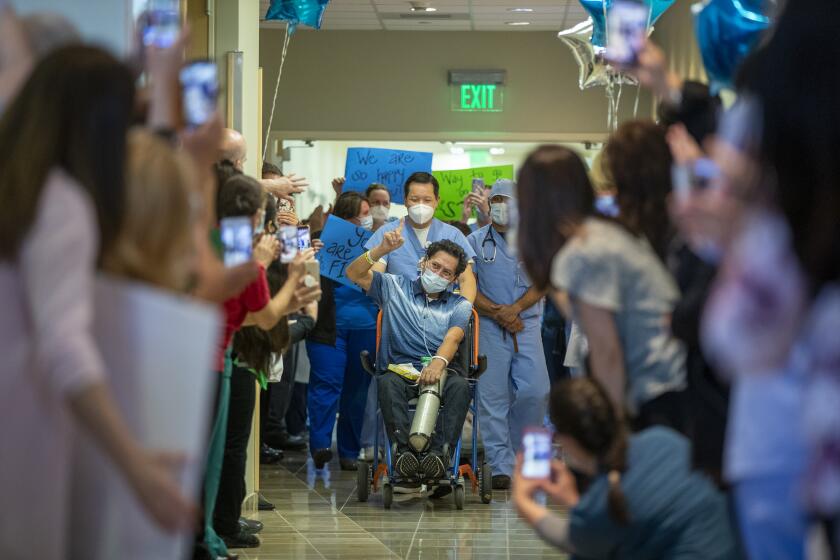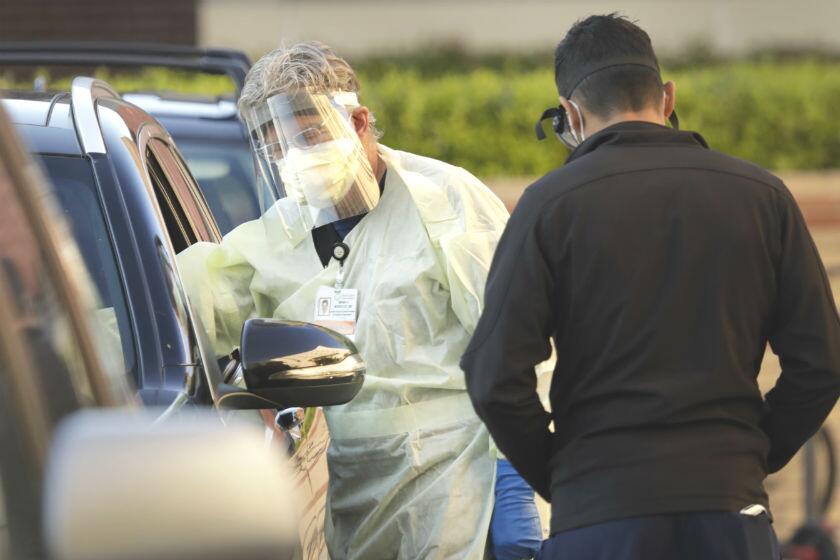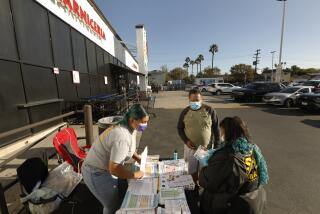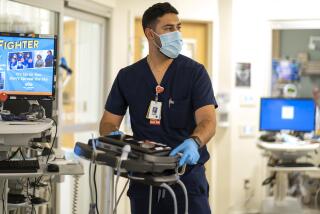L.A. County confirms 40 new coronavirus deaths, the highest toll in a single day
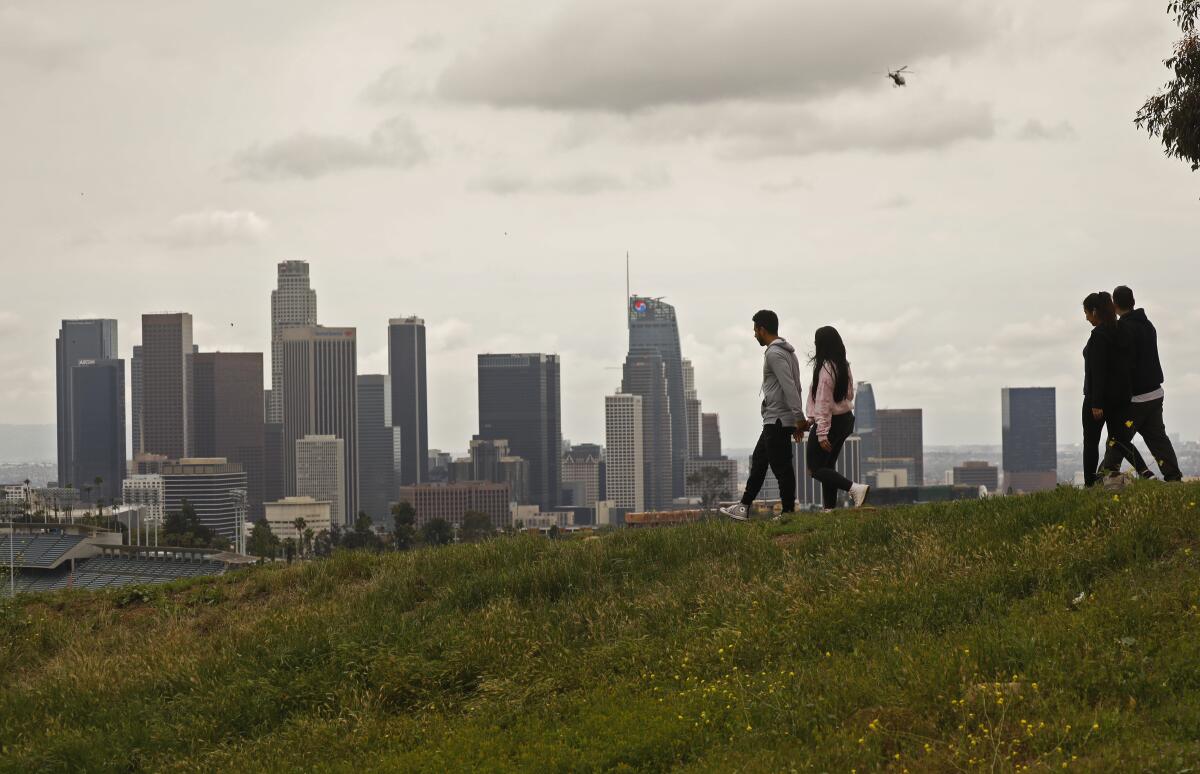
- Share via
Los Angeles County health officials Tuesday confirmed 40 more deaths linked to the coronavirus, the highest number reported in a single day.
The county’s death toll now stands at 360, Public Health Department Director Barbara Ferrer said, noting that the mortality rate has increased to 3.6%.
Ferrer confirmed 670 additional COVID-19 cases, bringing the county’s total to more than 10,000. Officials have previously said the case count includes people who have recovered, but there is no way to track those numbers.
Of more than 63,000 people who have been tested in the county, 11% were positive. Ferrer said that percentage could indicate that of Los Angeles County’s 10 million residents, “we could have as many as 1 million people at some point in time” who are infected. Of course, not every individual will obtain testing for COVID-19.
Mayor Eric Garcetti announced Tuesday that, thanks to increased testing capacity, anyone with COVID-19 symptoms can now book a same- or next-day appointment.
“Great news for anybody who’s feeling under the weather and has the symptoms,” he said at a news briefing.
Coronavirus cases in California have surpassed 25,000 as the state enters a new phase of the crisis: figuring out how and when to lift social distancing rules that have been credited with keeping deaths in the state relatively low.
California has seen more than 760 COVID-19 deaths, a fraction of the toll in hot spots such as New York and New Jersey.
Whereas New York has seen more than 195,000 confirmed cases, a rate of almost 1,000 cases per 100,000 people, California’s rate of cases remains closer to 62 cases per 100,000 people. In New Jersey, the rate of cases was 727 cases per 100,000 people, as of Monday.
These are some of the unusual new scenes across the Southland during the coronavirus outbreak.
Although state officials say California won’t hit a peak until May — and Los Angeles County has already extended its safer-at-home order until May 15, with the possibility of a further extension — officials are beginning to talk about how the economy could be restarted.
Gov. Gavin Newsom outlined the plan at his news briefing Tuesday. Before the stay-at-home order can be modified, California will need to increase testing, protect high-risk residents and expand hospital capacity, he said.
“I want you to know it’s not, it will not be a permanent state,” Newsom said of the restrictions put in place to fight the spread of the novel coronavirus. “We recognize the consequences of the stay-at-home orders have a profound impact on the economy, your personal household budget, your personal prospects around your future.”
The framework was developed in partnership with the governor’s counterparts in Washington and Oregon.
The number of new coronavirus cases reported daily across California shows signs of flattening. In hard-hit Los Angeles County, 25 additional deaths were reported Monday but only 239 new cases, the lowest daily case count since March 26.
“That’s a good thing,” Ferrer said.
But the numbers jumped again Tuesday.
Like Newsom, Ferrer said the county is considering modification scenarios but is not ready to implement a change in its restrictive measures.
“We will not ease restrictions until everything is in place,” she said.
Chief Executive Sachi A. Hamai sent a letter to all county employees announcing that they must wear cloth face coverings when interacting with one another and the public, effective Wednesday.
Starting at 11:59 p.m. Wednesday, the public will be required to wear face coverings at essential businesses in L.A. County, including shopping at grocery stores and visiting a doctor.
“You can make your own mask or use a scarf, bandana or old shirt,” Supervisor Kathryn Barger tweeted. “Thanks for keeping yourself and your community safe!”
Garcetti announced a similar order last week, requiring all residents to wear a face covering when visiting the majority of essential businesses, in hopes that it will protect workers and slow the spread of the coronavirus.
Barger said deputies will give warnings and may carry extra masks to encourage compliance.
“If it escalates, a deputy may opt to issue a citation, and a store can refuse service to someone not taking precautions,” she tweeted.
Sheriff Alex Villanueva, however, said Tuesday that deputies will not cite people for mask violations.
“We are looking for voluntary compliance. We have discussed it with all the police chiefs in the county,” Villanueva said. “We aren’t talking enforcement here.”
Coronavirus: All L.A. residents showing symptoms can now get coronavirus tests
As of Monday, sheriff’s officials had issued 19 coronavirus-related citations, including to owners of nonessential businesses who have stayed open in violation of the county’s stay-at-home order.
“They tend to run a gamut, but the one I think we’ve seen more than once are typically bars,” Villanueva has said.
L.A. City Atty. Mike Feuer said Tuesday that his office has charged 10 more nonessential businesses for staying open after they were warned to close, bringing the total to 14. He said they included a print shop, a spa, a beauty supply store and smoke shops.
Mark Ghaly, secretary of the California Health and Human Services Agency, said Monday that the state’s stay-at-home order and social distancing had slowed the spread of the virus, resulting in fewer hospitalizations than estimates predicted.
Under a worst-case scenario and without any mitigation efforts, state models predicted a peak of nearly 700,000 hospitalizations from COVID-19, Ghaly said last week. But he noted that adherence to the stay-at-home order, which Newsom announced nearly a month ago, now suggested that “the difference between what we’re seeing today in our hospitals may not be that much different than where we are going to peak in the many weeks to come.”
The governor said Monday that 3,015 people had been hospitalized in the state, including 1,178 who were receiving intensive care.
Nearly half of those hospitalized are in L.A. County, according to public health officials.
School won’t be the same when it resumes after coronavirus closures. There could be staggered start times, reconfigured classes and no assemblies.
At least 1,334 residents are hospitalized with COVID-19 in L.A. County, including almost 500 people who are in ICU beds, according to data collected from several hospitals by the Los Angeles County Department of Health Services.
About 22% of COVID-19 patients in ICU are on ventilators, according to the agency.
Although high for California, those numbers are still a fraction of what New York continues to see, where 1,600 additional COVID-19 cases were reported Monday, according to state officials.
“Lives lost yesterday, 778,” New York Gov. Andrew Guomo said during a briefing Tuesday. “That number is up. To me that’s the most painful number and it has been the most painful number every day, and those New Yorkers are in our thoughts and prayers. You look at the past few days and the number of lives lost, it’s basically flat at a devastating level of pain and grief but evidence is, everything else we’re seeing is basically a flattening at this level.”
Although life is still a long way from returning to pre-pandemic norms, some scientists believe parts of the economy could return to normal in the coming months under the right circumstances.
“Is it wearing masks? Probably. Is it continuing to restrict large gatherings? Yeah, probably,” said Dr. George Rutherford, an epidemiologist and infectious diseases expert at UC San Francisco. “When we return to work, do we all go back on the same day, or do we stagger that? Is it continuing to have older people stay home more than they would otherwise? Yeah, probably.”
Dr. Robert Kim-Farley, a UCLA medical epidemiologist and infectious diseases expert, said by summertime, perhaps in the middle of June to the end of July, there may be a nuanced, tailored approach for getting people back to work and easing stay-at-home orders. But those may not be a one-size-fits-all approach.
“I think this is the most significant public health pandemic of our lifetimes,” he said. “That is something to recognize.”
Times staff writer Richard Winton contributed to this report.
More to Read
Sign up for Essential California
The most important California stories and recommendations in your inbox every morning.
You may occasionally receive promotional content from the Los Angeles Times.
